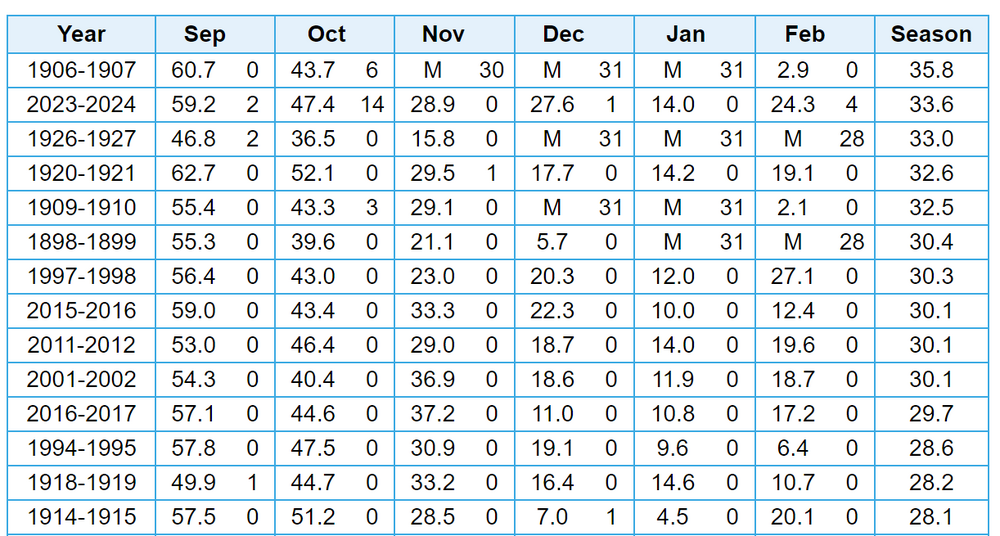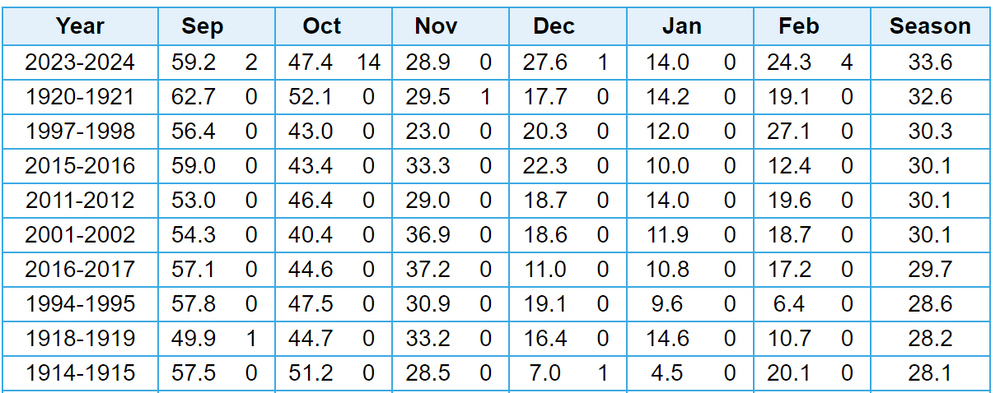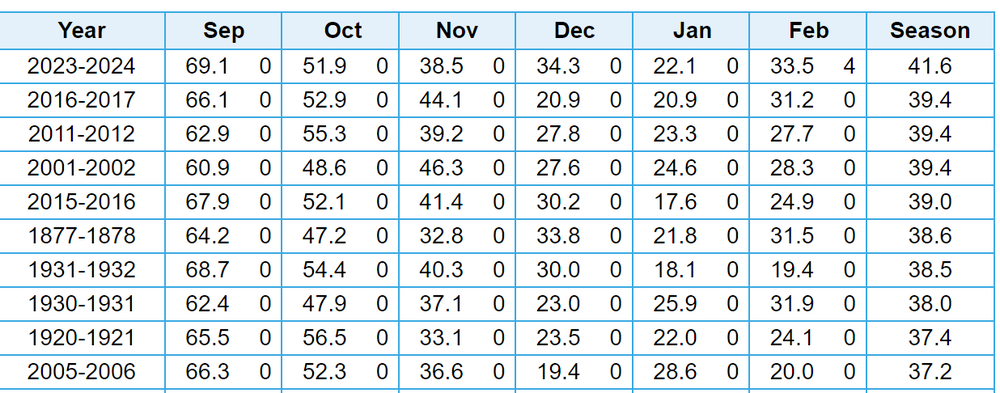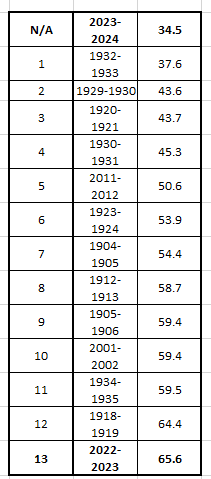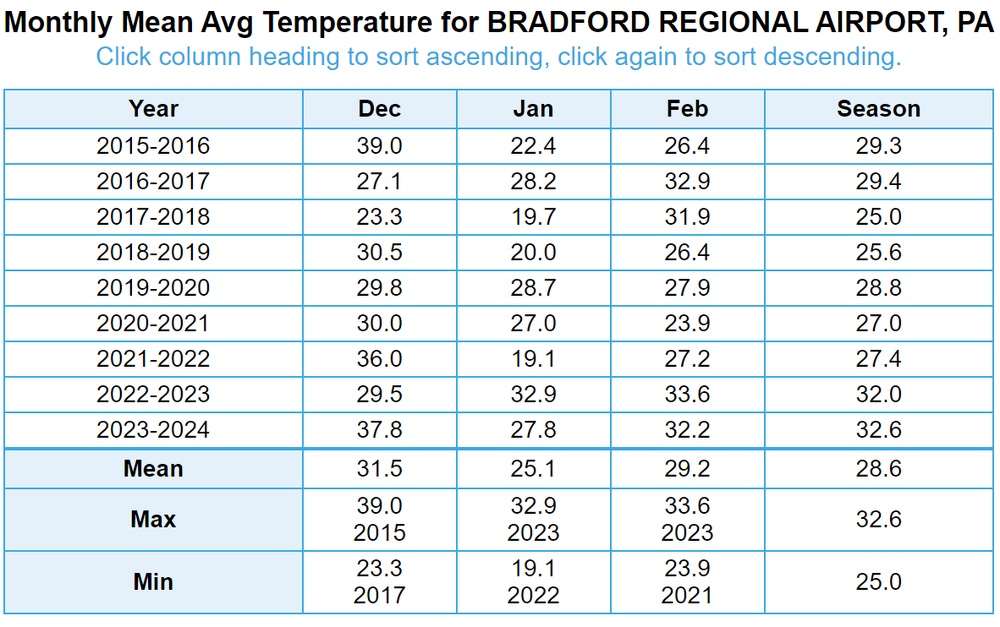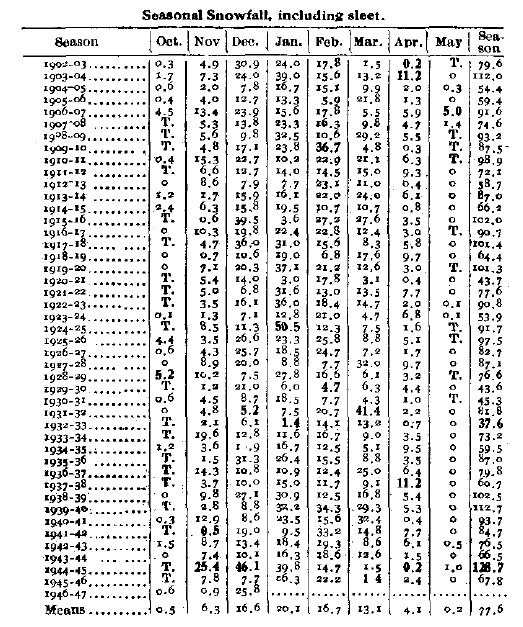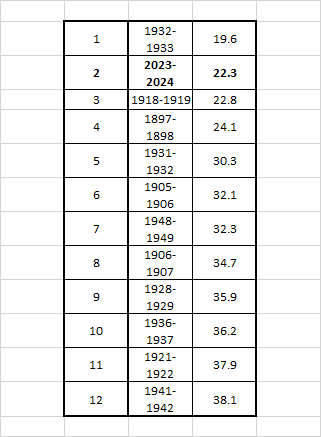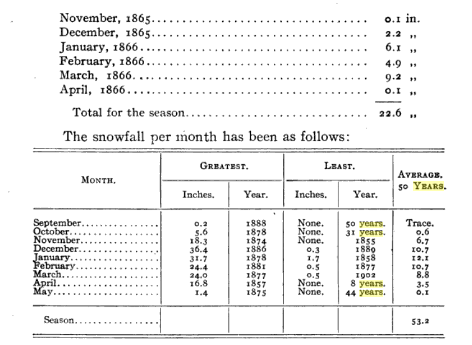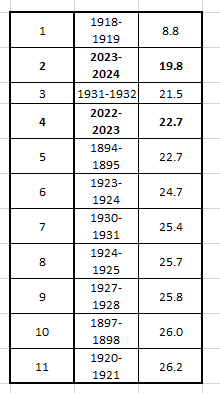
TheClimateChanger
Members-
Posts
4,044 -
Joined
-
Last visited
Content Type
Profiles
Blogs
Forums
American Weather
Media Demo
Store
Gallery
Everything posted by TheClimateChanger
-
All-time monthly maximum, dating back to at least 1874.
-
The current temperature at Detroit is 70F. This ties the February monthly record maximum. Prior to this year, the only other dates on which it reached 70F are 2/24/2017 & 2/11/1999.
-
The current temperature of 71F at Toledo ties the February monthly record high temperature. Still plenty of time to exceed that value. It previously hit 71F on 2/24/2017, 2/26/2000, 2/11/1999, and 2/26/1944.
-
Minneapolis has now set two outright monthly record high temperatures in the last 5 months (with records dating to 1872) - 92 in October, and 65 in February. Additionally, only one year exceeded the 98F reading from September (1931 - 104, on 9/10; and 99, on 9/8), and the 55F reading in January has been exceeded only twice (1/25/1944 - 58F; and 1/24/1981 - 57F). Honorable mention to August - the 98F reading has only been exceeded in 9 years (5 of them by just one degree).
-
Actually ticked up to 65F later in the day.
-
Chicago Weather Records Tracking
TheClimateChanger replied to Chicago Storm's topic in Lakes/Ohio Valley
And before @michsnowfreak chimes in, I'm not saying those weren't mild winters. From the data I've seen they were all warm winters. That period had some weird ups and downs with some colder winters interspersed with very mild winters, but clearly with 5 of the top 6 [prior to this season] from that era, it's being affected by the location and exposure of the observing station. -
Chicago Weather Records Tracking
TheClimateChanger replied to Chicago Storm's topic in Lakes/Ohio Valley
The official station for Chicago has moved around a lot. At the time, it was downtown and near the lakeshore, with a rooftop exposure. You can see the locations here from the 1947 annual climate data publication. You can see the thermometers were situated 70-75 feet above ground in the 1870s and 1880s, and then from 140 to 240 feet above ground until the move to the university. Looks like they were properly sited 7 feet about the ground there. Probably exaggerates the urban heat island effect since rooftop measurements tend to run warmer than ground temperatures. The downtown station at the Courthouse anyways did tend to run about 2-2.5F warmer than Midway Airport during the winter, and a degree or so warmer than the University of Chicago site. The yearly means at Midway and University of Chicago were similar, with downtown about 1-1.5F warmer. -
Occasional Thoughts on Climate Change
TheClimateChanger replied to donsutherland1's topic in Climate Change
-
INL set a monthly record high last month, but will come short of the February record high. Still one of only a handful of years in which it reached 50F or better in February.
-
MSP up to 63F. All-time monthly high of 64F from 1896 in jeopardy. All-time seasonal high of 68F from December 1998 appears to be safe.
-
Pittsburgh, Pa Winter 2023-24 Thread.
TheClimateChanger replied to meatwad's topic in Upstate New York/Pennsylvania
Made it all the way up to 68. Beautiful spring day. -
Pittsburgh, Pa Winter 2023-24 Thread.
TheClimateChanger replied to meatwad's topic in Upstate New York/Pennsylvania
Up to 64 on my weather station. -
-
At International Falls, limiting the analysis only to years with data for all months (of course), 2023-2024 is 1F warmer than 1920-1921 & 3.3F warmer than 1997-1998. Most of the early years in this list are missing multiple cold season months - i.e., the 33.0F in 1926-1927 is the mean of the fall only and is 0.6F colder than the mean of fall and winter this year.
-
Prolific, long-lasting warmth. The mean of the preceding 6 months at MSP is 2.2F warmer than any prior year of record over the same period.
-
Pittsburgh, Pa Winter 2023-24 Thread.
TheClimateChanger replied to meatwad's topic in Upstate New York/Pennsylvania
All in all, we've done incredibly well with snowfall this winter with only 6.5" less than Erie to date, per the official observations. -
Pittsburgh, Pa Winter 2023-24 Thread.
TheClimateChanger replied to meatwad's topic in Upstate New York/Pennsylvania
Sorry, had to include March 1 since it doesn't accept February 29th as an end date. Good chance for 3 more in 2024. Certainly a long-term uptrend, but not a huge change since the 1990s. Bigger upswing since 2015, however. -
Yes, pretty bad. I looked into this yesterday. As @BuffaloWeather pointed out, the pre-1949 numbers aren't really directly comparable to the modern values since the city station is less favored for LES than the airport and averaged significantly lighter snowfall. Note that xMacis is missing a lot of data, so I had to dig into the old Monthly Weather Review to find the complete seasonal totals for some of the earlier years at the city office. Last year was the third least since the winter of 1934-1935 [only 2011-2012 & 2001-2002 saw less snowfall], but this winter has seen barely half of last year's total thus far. Another 16.1" could fall, and it would still be the least ever observed at KSYR and top 5 least in the threaded record. And the advent of snowboards and periodic 6-hourly measurements certainly inflates some of the recent tallies compared to many decades ago, especially with fluffy, airy lake effect snow.
-
Also BTV. Most recent 9 year period [March - February calendar] is averaging 48.8F versus a 45.9F average from 1981-2010. So that's about 3 degrees for the entire year, not just winter. March 1980 - February 2010 Average Note: The warmest 12-month period from 3/80 - 2/10 is 0.7F below the mean of the last nine years.
-
That's child's play. How about +5.1F over a 9-year period? The coldest February is the same average as the 1981-2010 mean for the month, and the coldest winter season 1.5F above the 1981-2010 mean. 1981-2010 Averages
-
Winter '23-'24 Piss and Moan/Banter Thread
TheClimateChanger replied to IWXwx's topic in Lakes/Ohio Valley
Yeah, no doubt site location changes can make a huge difference. I've pointed this out here, but received pushback from some of the southeast Michigan crew. I don't think they realize how snowfall totals can easily vary by a foot or two in the snowbelts in a matter of miles or over a couple hundred feet of elevation. I just included all of the corrected data [as noted, xMacis is missing a lot of the snowfall pre-1940] to provide a useful comparison. Even neglecting the bias introduced by location and procedural changes, last winter was 13th least in the threaded record and this winter is well on track to place in the top 5. Still over 3" under the current least snowy winter (1931-1932). In fact, post-1935, only the winters of 2001-2002 & 2011-2012 had less snowfall in Syracuse than last winter. -
Winter '23-'24 Piss and Moan/Banter Thread
TheClimateChanger replied to IWXwx's topic in Lakes/Ohio Valley
Here's Syracuse, NY. XMacis has a ton of missing data from the early years. However, the Monthly Weather Review shows the correct figures for those years: Again, the average was quite a bit less than the modern values, probably in part attributable to site location changes and measuring techniques. But also there's likely been an actual, significant increase in snowfall downwind of the lakes due to the decreasing ice coverage season/warmer water temperatures. Anyways, using the corrected values, I put together a list of the top ten least snowy winters for Syracuse [neglecting any site changes, snow board impacts, etc..]. With the current winter shown for comparison. Records date to 1902. Last year appears to have been the 13th least on record, just below the infamous mild winter of 1918-1919. In recent decades, only 2001-2002 & 2011-2012 had less snowfall. -
Winter '23-'24 Piss and Moan/Banter Thread
TheClimateChanger replied to IWXwx's topic in Lakes/Ohio Valley
Erie's not much better. With records dating to 1892-93, pretty rough. Note there are errors in xMacis, including showing 12.1" in 1943-44 and 22.8" in 1942-43. Actual values were 48.5" [including 4th most on record in October - 8.2"] in 1943-44, and 47.0" in 1942-43. The value of 26.5" shown by xMacis for 1931-32 is missing the snowstorm of 3.8" on March 31, 1932. 1928-29 is missing a few inches. Etc... The correct values are given below. Again, this is ignoring any site changes or changes in snow measuring techniques over the course of the 20th century. This was a big issue in 2017-2018, when it was discovered the observer was clearing the snow board hourly resulting in wildly inflated totals relative to what was actually accumulating on the ground. Since 1948-49, the lowest total at the airport is 41.2" from the winter of 1982-83. In more recent decades, 46.9" was observed in 2011-2012, 48.4" in 1997-1998, and 52.0" last winter. So yeah, definitely nothing remotely close to the current winter since at least 1950. Let alone back to back duds. Also, of the current tally of 22.3", 2.3" was from a fluke October snowfall, and so only 20.0" have occurred since November 1 at Erie. -
Winter '23-'24 Piss and Moan/Banter Thread
TheClimateChanger replied to IWXwx's topic in Lakes/Ohio Valley
Some people have a very myopic POV here. This is the Great Lakes & Ohio Valley sub-forum, not the Detroit area sub-forum. Anyways, for further context as to how awful the recent snowfall history has been at Cleveland: Last year was third least on record, and this winter is still below last [albeit with some time left to shoot up]. Moreover, it's worth pointing out during the 1920s and 1930s, the average was only about 40"-ish a winter - obviously impacted by the downtown, rooftop siting, and different snow measuring techniques and procedures. Since moving to the airport, the average has always been mid 50s to mid 60s [briefly high 60s] range [in inches per year]. If we limit this to the Cleveland airport site, the lowest of record prior to the most recent two winters is 30.4" from 1948-1949. But it gets even better, there was a dedicated observer near downtown Cleveland who was recording temperature, precipitation and snowfall all the way back to 1854-55. The lowest total he had measured was 22.6 inches, from 1865-66 [which was actually a cold winter]. Unfortunately, I do not have all of the seasonal numbers, but we can conclude every other winter was at least 22.7 inches. So I mean, we can conclude the 22.7 inches observed last year was 4th least dating back to at least 1854-1855, and two of the higher ranked ones were 0.1 inches less and 1.2 inches less [largely negligible differences over the course of the winter]. And this is even ignoring the impact of moving the station out of the city, and utilizing snow boards and 6-hourly measurements in more recent decades. I mean that's pretty bad. And beyond the early 1850s, you're heading well into Little Ice Age territory, so it's probably unlikely that there would have been many milder winters prior to that era. -
I mean I'm obviously not endorsing him. In fact, the opposite. He presents past news stories as evidence of past climate change to downplay the changes happening today - which is obvious nonsense. I'm instead using those same stories to show how the news media treated periods of weather in the past that would be mild by today's standards.




